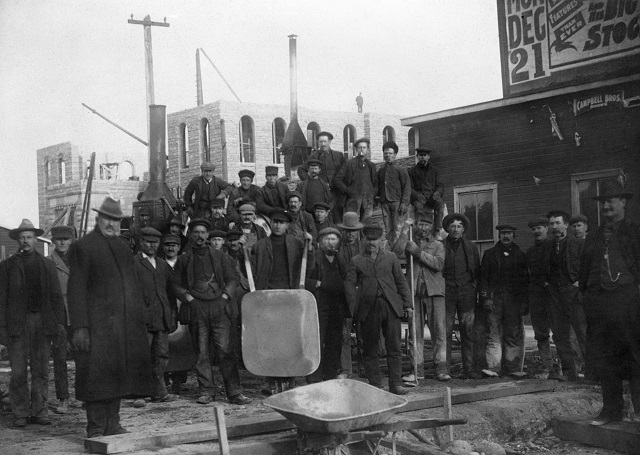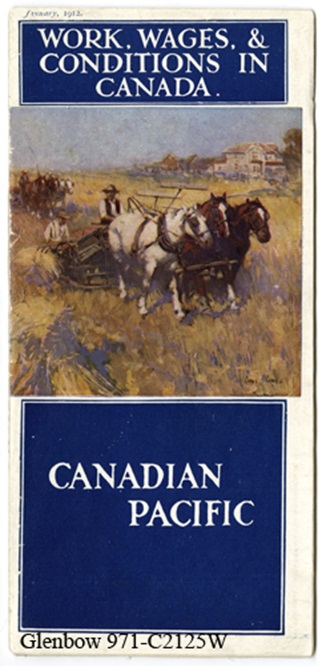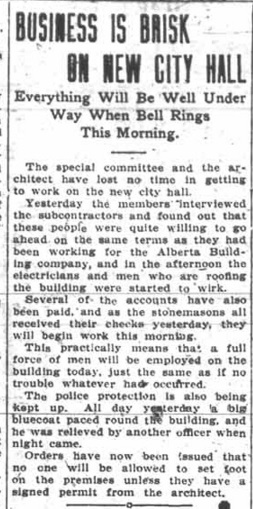Typical wages when Historic City Hall was built
Though work in the construction industry could be precarious and seasonal, wages overall were good during Calgary’s boom years from 1906 to 1913. Carpenters and stone workers were the highest paid craftsmen in the city, typically earning 45¢ and 55¢ cents per hour respectively. According to payroll records for the construction of City Hall, masons and stonecutters were paid 60¢ per hour (plus an additional 5¢ for foremen), while mason labourers earned between 32.5¢ and 35¢ per hour. This represented a significant increase from the late nineteenth century, when masons earned between $1.50 and $2 per day. On the other hand, the prices for staple goods and services had also risen sharply, and wages in Calgary were generally not high enough to meet the cost of living for most workers and their families.
In response to this challenge—and the great demand for skilled craftsmen—the building trades became increasingly willing to use collective action to improve wages and work conditions. The number of unions in Calgary rose from just three in 1900 to forty in 1912, with a total membership of 3,281; for carpentry and the brick trades, the rate of unionization was close to 100 percent. The Calgary local of the Bricklayers and Stonemasons International Union staged two strikes before 1914. However, stonecutters’ relative power compared with other building trades was declining as a result of technological changes and increasing mechanization, which reduced the stonecutters’ importance. While wages for bricklayers and carpenters rose by 28 and 34 percent respectively between 1901 and 1915, wages for stonecutters rose by only 19 percent. Stone masons and cutters in Calgary also compromised their own success through an ongoing dispute in which both groups claimed the exclusive right to cut sandstone and tried to outbid each other for contracts.

The construction crew of Historic City Hall, circa 1908-1909. Courtesy Glenbow Archives
The carpenters’ union in Calgary was more assertive and more willing to strike, which they did seven times between 1901 and 1914. To prevent any trouble, the City Hall Committee signed a memorandum of agreement with both the Calgary Builders’ Exchange and the United Carpenters’ Council. The agreement outlined the standard workweek, which consisted of eight hours per day Monday to Friday, plus half days Saturday. The agreement also contained other beneficial terms for carpenters, such as time-and-a-half pay for overtime. However, it also reveals how precarious work could be, as the contractor was required to provide only one hour’s notice of being “discharged”—just enough time to get one’s tools in order. Further, employment was highly seasonal because of Calgary’s unpredictable and often harsh weather conditions. Wage earners in the building trades typically worked only seven to eight months, with no provision for the remainder of the year.
 While most promotional materials presented a very idealistic picture of Canada, this 1912 pamphlet, published by the Canadian Pacific Railway, offered more concrete details on employment and wages with a few cautionary notes. Stockmen and experienced farm hands could expect to make between $20 and $25 (with board) a month during the summer but there were very few year-round positions. In Calgary, experienced stone-masons and bricklayers made 55 cents per hour while carpenters received 45 cents; that, however, was for a 7-8 month season (depending on weather). Women were always needed in domestic service; in Alberta, farm servants could make up to $15 per month (board and lodging included) but in Toronto, domestic servants could expect only $10.00. However, there were very few opportunities for women in factories, where local supply more than met the demand. Pamphlet courtesy Glenbow Archives
While most promotional materials presented a very idealistic picture of Canada, this 1912 pamphlet, published by the Canadian Pacific Railway, offered more concrete details on employment and wages with a few cautionary notes. Stockmen and experienced farm hands could expect to make between $20 and $25 (with board) a month during the summer but there were very few year-round positions. In Calgary, experienced stone-masons and bricklayers made 55 cents per hour while carpenters received 45 cents; that, however, was for a 7-8 month season (depending on weather). Women were always needed in domestic service; in Alberta, farm servants could make up to $15 per month (board and lodging included) but in Toronto, domestic servants could expect only $10.00. However, there were very few opportunities for women in factories, where local supply more than met the demand. Pamphlet courtesy Glenbow Archives


